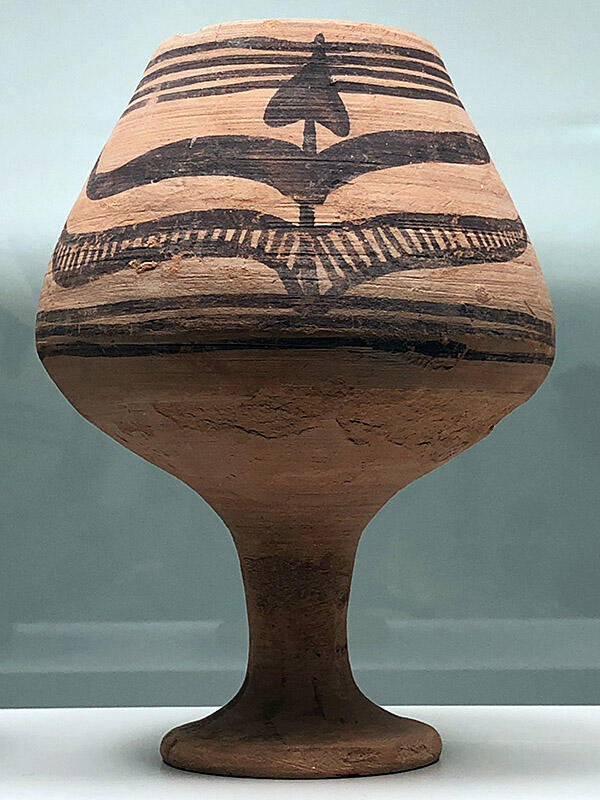A painted goblet from Mundigak IV, dated from approximately 2500-2000 BCE. Note the stylized design accompanying the pipal leaf, also seen on the painted bowl opening this series.
Bridget and Raymond Allchin describe "the emergence of a Baluchistan 'province' of ceramic decoration . . .. Stylized plant motifs, particularly the pipal leaf, occur as well as less obvious plant and bird motifs. The art of pottery painting seems to have reached its peak in these regions in the late fourth and early third millenia, with the graceful fish or animals of the polychrome Nal ware, the naturalistic friezes of animals or pipal leaves of Mundigak IV, the 'Animals in the landscape' motifs of Kulli ware, recalling the 'Scarlet' ware of Diyala and Susa in south-west Persia, and many more. The whole of this development shows strong Iranian parallels, and many of the patterns and motifs can – in a general, rather than a precise way – be paralleled in Iran. Indeed, in broadest terms, the Baluchi style of pottery appears as a regional development. It is also interesting to wonder whether any of the designs were shared in the decoration of textiles. It is often striking to find in modern carpets motifs recalling those used anciently in Baluchistan" (The Rise of Civilization in India and Pakistan, 1982, p. 140).
Sylvia Matheson writes: "The monument colonnade had been suddenly and violently destroyed by attackers, probably the builders of the monument massif [the Mundigak V structure built on top of the Mundigak IV monument colonnade] and the creators of the coarse pottery. They were obviously an entirely different people from those who hail made the graceful buff “brandy balloons” similar to the Kulli-ware of Baluchistan and that of the Indus Valley, pottery that was tentatively dated at the second half of the third millennium.
"Now supposing a considerable number of the buff sherds had been found among the later coarse red ones, this could imply a mingling of the two cultures and a gradual absorption of one into the other. Or it might mean that someone on the dig had been careless in labelling baskets just at the time of transition from one layer to the next, and had mixed the two levels. Supposing the red pottery had been found among the buff of the earlier layer? The confusion that this must arouse can best be visualized by imagining' hat you were exploring the ruins of a bombed council house in London just after the war. If you found a seventeenth-century coin you might assume with good reason that (a), the victim of the air raid had been a numismatist, or (b) that the house had been built on the site of a much older one from whose foundations had come the coin, or (c) that it had even been dropped by a careless present-day passer-by.
"Supposing you were digging a Saxon burial mound and had gone through a foot or so of obviously undisturbed soil and there among the warrior’s bones and the weapons and sherds of funerary pottery in your finds basket, you discovered a piece of a Picasso dish! Knowing your site you would assume that someone must have deliberately “planted” the twentieth-century sherd in the ground, or carelessly dropped it in the wrong basket. But imagine how confusing thu sort of thing can be when you are digging a completely unknown, undated site!
"As Sir Mortimer Wheeler once said, 'Pottery is the alphabet of archaeology’ and, in order to read the language it spells, it is absolutely essential to keep the finds of each level completely separate." (Time off to Dig, London, 1961, pp 91-92)

